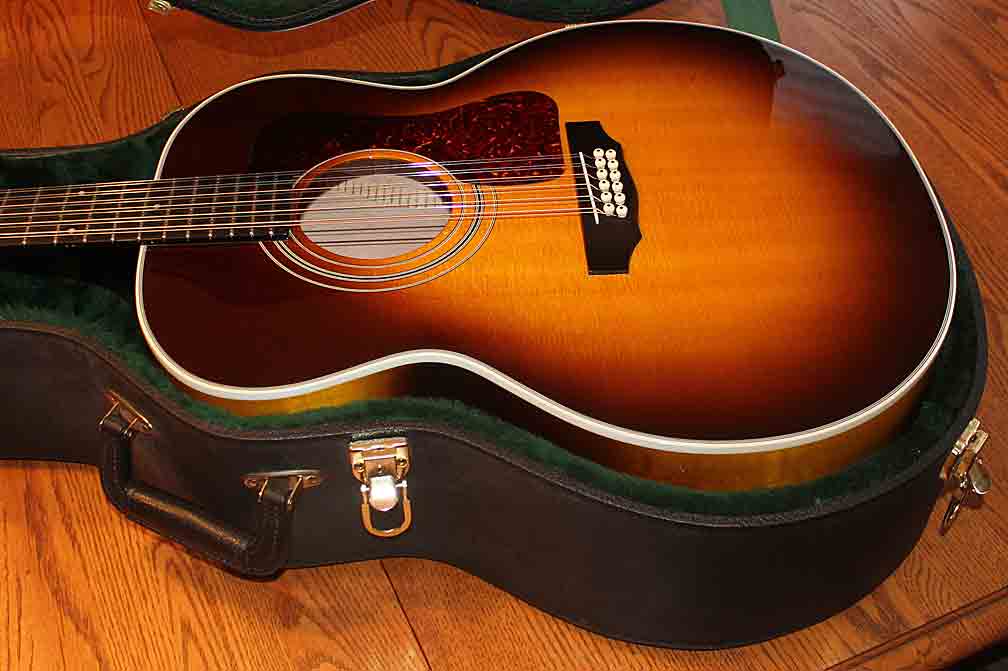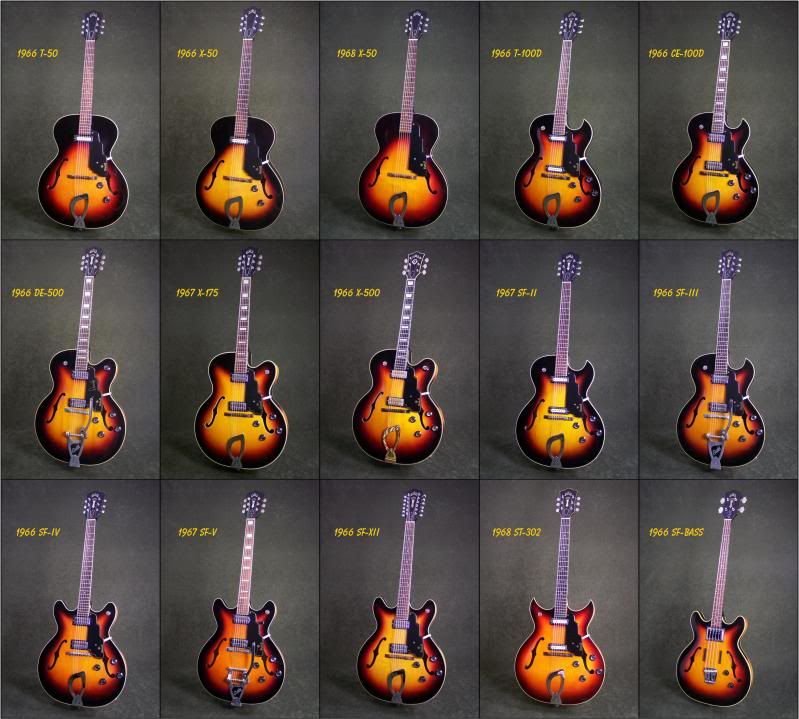You are using an out of date browser. It may not display this or other websites correctly.
You should upgrade or use an alternative browser.
You should upgrade or use an alternative browser.
Burst Finishes
- Thread starter richardp69
- Start date
Midnight Toker
Senior Member
- Joined
- Nov 7, 2021
- Messages
- 1,871
- Reaction score
- 3,322
- Guild Total
- 2
True, the cherry red dye typically faded from exposure, (most faded ones still have a cherry red ring under the pup selector ring) but many were also what today would be considered tobacco bursts. More brown from the start, and a lot less fading in result. Oddly enough, several examples of cherry bursts from those first three years seem to have done all their fading in the first 10 years as good color pics from the late 60's show little to no difference to pics of the very same guitar today, despite an additional 50+ years of exposure!I think the variations seen in that poster have more to do with how the individual guitars aged than how they were finished.
A beautiful cherry burst that's been left in a store window for years is going to look more like the top ones than the bottom.
mavuser
Enlightened Member
game over!! thanks for playin
mavuser
Enlightened Member
Do you live in a park? Very mice!
I live near that park (driving distance), not in it, unfortunatley. it's Teddy Roosevelt's house/National Park Preserve.
Cougar
Enlightened Member
Whiskey burst....


Charlie Bernstein
Senior Member
I love two-knob electrics. That one's a cutie.amber burst

Charlie Bernstein
Senior Member
Gorgeous. I had a sweet late-forties sunburst ES-150. Sold it about three years ago. Fattest neck and bluesiest pickup I've ever played.Fun fact: Historically, Gibson has often up-charged for natural finishes on many models (not all). Conversely, Martin has historically up-charged for sunburst finishes on many models.
I'm not typically a big fan of sunburst finishes, but this one really does it for me (1966 ES-125T):

GGJaguar
Reverential Member
Two is all you need. Usually.I love two-knob electrics.
Charlie Bernstein
Senior Member
With four I spend all my time twisting them. BTDT. I wanna play.Two is all you need. Usually.
The original intent may not have been to cover up 'bad wood' but in effect, lesser visual grades could be used with sunburst finishes. Gibson had an upcharge for "N" guitars, because the wood had to be flawless to be used. So there was likely sorting.This is the internet, after all, where anybody can print anything and everybody else can agree, or not.
That said, there are anecdotes that have "sunburst" finishes on musical instruments at least as far back as WW I and possibly as early as 1906 on Gibson mandolins, so the burst predates the Les Paul. There are also anecdotes that what constituted "inferior" has varied over time and is a matter of opinion. Consider "bearclaw" on acoustic tops as an example of something that was once considered a flaw but is accepted or sought after now.
There were similar finishes on 19th century furniture at least in the sense that the center was deliberately lighter than the edges. That was done for decorative purposes.
So, like many ideas that cannot be attributed to a single source where the source documented the motivation, maybe the burst guitar finish originally had some other purpose than to hide "inferior" wood.
There is documentation that Gibson used bursts during WWII and the factory workers thought that was being done because of the wood available during WW II. (There is no truth to the rumor that Gibson had to compete with Howard "Spruce Goose" Hughes for spruce).
I believe the cover up story in various times and places but I am not going to claim that is why the 'burst was originated or first used.
And to flip this, a story which I believe to be true but cannot reveal my source, is that a factory attempted to spray some bursts on a production electric guitar. The bursts were so bad that the guitars were refinished in solid colors and then the marketing weasels sold those "custom colors" at a slight premium over the usual finishes.
Fender absolutely used custom colors to cover up bad finishes, but not necessarily 'bad wood,' at least in the Leo days.
And of course, there is 'appliance burst.' Check out the edges
![FrididaireAvocado[1].jpg FrididaireAvocado[1].jpg](https://letstalkguild.com/ltg/data/attachments/39/39939-410bae3feaf92069de062e8cdeef3112.jpg)
or Clownburst
![ClownburstGallery[1].jpg ClownburstGallery[1].jpg](https://letstalkguild.com/ltg/data/attachments/39/39940-79646331cdf0f6d86991b72c8ceba340.jpg)
I think Guild did some of the most attractive sunbursts on acoustic guitars.
cupric
Senior Member
- Joined
- Apr 20, 2018
- Messages
- 1,930
- Reaction score
- 1,362
- Guild Total
- 3
amber bur
I remember those avocado burst appliances! They probably still work. Lol!The original intent may not have been to cover up 'bad wood' but in effect, lesser visual grades could be used with sunburst finishes. Gibson had an upcharge for "N" guitars, because the wood had to be flawless to be used. So there was likely sorting.
Fender absolutely used custom colors to cover up bad finishes, but not necessarily 'bad wood,' at least in the Leo days.
And of course, there is 'appliance burst.' Check out the edges
or Clownburst
I think Guild did some of the most attractive sunbursts on acoustic guitars.
What's that odd green color Fender Strats had? Pretty much the same.
My friend called that "Linda Blair green."
The only real greens I know in Fenders is Sherwood Green Metallic, and a yellowed Antigua - now that's a burst!What's that odd green color Fender Strats had? Pretty much the same.
![tfoczhka7xoycexvokiu[1].jpg tfoczhka7xoycexvokiu[1].jpg](https://letstalkguild.com/ltg/data/attachments/39/39943-5a96015a3c2dfc8000302ef68bf2584c.jpg)
[Who was the idiot who decided that the pickguard should cover the mounting rings? Bleeech]
Sonic blue ages green due to a yellowing of the top coat.
cupric
Senior Member
- Joined
- Apr 20, 2018
- Messages
- 1,930
- Reaction score
- 1,362
- Guild Total
- 3
Yes! Antigua. The original (?) was a limish green x avacado. Burst.
kitniyatran
Senior Member
I love two-knob electrics. That one's a cutie.
One of the best things about my 1965 Kalamazoo made Epiphone amplifier is, volume knob Reverb knob vibrato knob and no more knobs.
Charlie Bernstein
Senior Member
I know I don't have to tell you to hold onto it.One of the best things about my 1965 Kalamazoo made Epiphone amplifier is, volume knob Reverb knob vibrato knob and no more knobs.
My late, great '62 Ampeg was pretty unencumbered, too: Volume and tone and a disconnected a trem pedal.
Traded it for my knob-free Guild.
Last edited:
